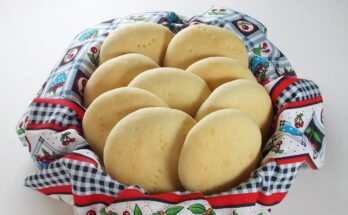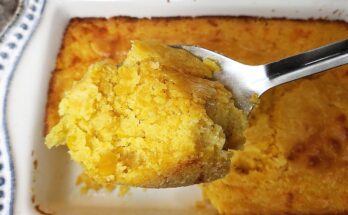Juicy Meatloaf Recipe: If you’re craving that nostalgic, home-cooked comfort food, a juicy meatloaf is the answer. There’s something undeniably satisfying about slicing into a perfectly cooked loaf that’s packed with flavor, super moist, and slathered with a caramelized glaze. Whether it brings back childhood memories or you’re just after a hearty, budget-friendly dinner, meatloaf hits the mark.
But let’s be honest—making a truly juicy meatloaf isn’t always as easy as it seems. Dry, bland meatloaf? Nobody wants that. That’s why I’m going to walk you through everything step by step. From the perfect meat ratio and essential ingredients to shaping, glazing, and baking, we’ve got you covered.
Ready to make the juiciest meatloaf ever? Let’s get into it.
List of Ingredients You’ll Need
Basic Ingredients
Here’s a breakdown of the key ingredients you’ll need for your juicy meatloaf. These aren’t just random components—they’re each chosen for texture, flavor, and moisture retention.
- Ground meat (2 lbs) – Ideally a mix of 80/20 ground beef and ground pork. This combo adds fat and flavor.
- Breadcrumbs (1 cup) – Plain or seasoned. Soaks up juices and binds the meat.
- Eggs (2 large) – Acts as a binder and adds richness.
- Milk (½ cup) – Moistens the breadcrumbs and prevents dryness.
- Onion (1 medium, finely chopped) – Adds sweet, aromatic flavor.
- Garlic (2 cloves, minced) – For depth and zing.
- Salt (1½ tsp) – Balances and enhances flavor.
- Black pepper (1 tsp) – Adds a little kick.
Optional Ingredients for More Flavor
Want to level up your loaf? Try these:
- Worcestershire sauce (2 tbsp) – Adds a savory, umami punch.
- Dijon mustard (1 tbsp) – For tangy depth.
- Parsley or thyme (1 tbsp, chopped) – Fresh herbs brighten it up.
- Shredded cheddar cheese (½ cup) – For a creamy interior twist.
- Bell pepper or celery (½ cup, finely chopped) – Optional veggies for texture.
For the Glaze
This sweet and tangy glaze adds a beautiful finish:
- Ketchup (½ cup)
- Brown sugar (2 tbsp)
- Apple cider vinegar (1 tbsp)
- Optional: A touch of BBQ sauce or hot sauce for a kick
This combo creates that glossy, sticky topping everyone fights over.
Tools & Equipment You’ll Need
Before diving into the cooking process, make sure your kitchen is set up for success. A good recipe becomes great when you have the right tools at hand. Here’s what you’ll need:
- Large mixing bowl – For combining all the ingredients evenly.
- Loaf pan (optional) – For traditional meatloaf shape. A 9×5-inch pan works best.
- Baking sheet – If you prefer a free-form loaf, which allows the edges to crisp up nicely.
- Parchment paper or foil – To line your pan or baking sheet for easier cleanup.
- Chef’s knife and cutting board – For chopping your onions, garlic, and any additional veggies.
- Frying pan or skillet – To sauté your aromatics (onions, garlic, etc.) before mixing.
- Meat thermometer – To ensure your meatloaf hits the perfect internal temperature (160°F).
- Silicone spatula or wooden spoon – For mixing ingredients gently without overworking the meat.
- Measuring cups and spoons – Precision is key, especially when adding moisture.
Having all this within arm’s reach means less stress and a smoother cooking experience. Let’s now roll up those sleeves and get to the good part—making that juicy meatloaf.
Step-by-Step Guide to Making Juicy Meatloaf
Step 1: Preheat Your Oven
Preheat your oven to 350°F (175°C). A properly heated oven ensures even cooking and prevents the outside from drying out before the inside is done.
Step 2: Choose the Right Ground Meat
Use a blend of ground beef (80/20) with pork or veal for maximum juiciness. Turkey works too, but choose a higher-fat blend. Fat content helps keep the meatloaf moist.
Step 3: Prepare the Flavor Base
Sauté chopped onions, garlic, celery, or carrots in a little butter until soft. This step adds depth and sweetness while preventing crunchy, undercooked vegetables in your meatloaf.
Step 4: Mix Ingredients Properly
Combine the cooked aromatics with the meats. Mix gently with your hands or a fork. Overworking creates a dense, tough loaf.
Step 5: Add Moisture and Binders
Add eggs, milk, and breadcrumbs (or crushed crackers). Use just enough breadcrumbs to hold the loaf together—too much makes it dry. A balance of dairy and egg keeps the texture soft.
Step 6: Form the Meatloaf
Shape the mixture into a loaf on a baking sheet (free-form) or press it lightly into a loaf pan. Free-form meatloaf cooks more evenly and browns well on all sides.
Step 7: Create the Glaze
Mix ketchup, brown sugar, and mustard. Apply half before baking and reserve the rest for the final 10 minutes. The glaze adds sweetness, moisture, and shine.
Step 8: Bake to Perfection
Bake 50–60 minutes depending on size. Avoid overbaking—this is the main cause of dryness.
Step 9: Check Internal Temperature
Insert a thermometer into the center. The meatloaf is perfectly cooked at 160°F (71°C).
Step 10: Rest Before Slicing
Let it rest 10 minutes before slicing. This helps juices redistribute, ensuring a moist, tender meatloaf every time.
Enjoy your perfectly juicy homemade meatloaf!
Tips for a Super Moist Meatloaf
Want to take your meatloaf from good to legendary? Here are the top tips for locking in that juiciness every time:
1. Don’t Overmix the Meat
- Mix until just combined.
- Overmixing = tough meatloaf.
2. Use the Right Fat Ratio
- Skip the ultra-lean ground beef.
- 80/20 blend gives the best results.
3. Don’t Skip the Milk and Eggs
- They’re essential for moisture and structure.
4. Sauté the Veggies
- Raw onions can release water during baking and make your loaf soggy.
- Cooking them first enhances both flavor and texture.
5. Let It Rest
- As tempting as it is to dive right in, resting is what seals in the juices.
6. Double Glaze for Extra Flavor
- Add a second glaze halfway through cooking or near the end.
- Broil briefly for a sticky finish.
These hacks might sound small, but they make a world of difference.
Variations of the Classic Meatloaf
Let’s face it—while the classic version is unbeatable, sometimes you want to switch things up. One of the best things about meatloaf is how versatile it is. Whether you’re looking for new flavor profiles, healthier options, or something to surprise your guests, here are some delicious variations to try:
Italian-Style Meatloaf
- Swap ketchup for marinara sauce.
- Add Italian seasoning, garlic, and basil.
- Mix in mozzarella or parmesan cheese.
- Serve with extra sauce and pasta on the side.
This version is bold, cheesy, and rich in herbs. It tastes like a big meatball with structure.
BBQ Meatloaf
- Use BBQ sauce instead of the ketchup glaze.
- Add smoked paprika, chili powder, or a splash of liquid smoke to the meat mix.
- Mix in cheddar cheese and chopped onions.
The smoky sweetness of BBQ sauce gives the meatloaf a backyard barbecue flavor that’s perfect year-round.
Cheese-Stuffed Meatloaf
- Flatten the meat mixture on wax paper, layer with cheese (cheddar, mozzarella, or even pepper jack), then roll it into a loaf.
- Bake as usual, but slice carefully to see the gooey, melted center.
This is a total showstopper. Ideal for family gatherings or just when you need to impress yourself.
Turkey or Chicken Meatloaf
- Swap beef/pork for ground turkey or chicken.
- Add extra moisture (a touch more milk, sautéed veggies, or grated zucchini).
- Use bold seasonings—poultry needs help in the flavor department.
Great for lighter meals, and it’s still delicious when done right. Just don’t overcook it, or you’ll lose the juiciness.
Vegetarian Meatloaf
- Replace meat with a combo of lentils, mushrooms, beans, and oats.
- Use flaxseed or mashed sweet potatoes as a binder.
- Add chopped nuts for texture.
This one is perfect for Meatless Mondays and is surprisingly filling. It’s a hearty, plant-based spin that can satisfy even the carnivores at your table.
Serving Suggestions
A great meatloaf deserves great sides. Here’s how to make your meal truly complete:
Classic Pairings
- Mashed Potatoes: Creamy, buttery, and perfect for catching all that glaze.
- Green Beans or Peas: Light and fresh to balance the richness.
- Mac & Cheese: For a comfort-food feast.
Healthier Sides
- Roasted Vegetables: Try carrots, Brussels sprouts, or sweet potatoes.
- Steamed Broccoli: Simple and clean.
- Quinoa or Cauliflower Mash: Low-carb but still satisfying.
Sauce Ideas
- Serve with extra glaze or a simple brown gravy.
- A spoon of horseradish cream sauce can add tang.
- Pair with spicy sriracha ketchup for a little heat.
You can even turn leftover slices into sandwiches. Just toast some bread, add lettuce, tomato, a little mustard—and boom, next-level lunch.
How to Store and Reheat Leftovers
One of the best parts about meatloaf? Leftovers that actually taste better the next day.
Storing in the Fridge
- Let meatloaf cool completely.
- Wrap tightly in foil or plastic wrap, or store in an airtight container.
- Will keep in the fridge for 3–4 days.
Freezing Meatloaf
- Wrap entire loaf or individual slices in foil, then place in freezer bags.
- Label and freeze for up to 3 months.
- Thaw overnight in the fridge before reheating.
Reheating Tips
- Oven (Best Method): Wrap in foil and bake at 325°F for 20–25 minutes.
- Microwave (Quick Fix): Cover slices with a damp paper towel and microwave in 30-second intervals.
- Skillet: Heat gently with a splash of water or broth, covered with a lid.
Avoid overheating, especially in the microwave, as it can dry out the meatloaf. A drizzle of extra glaze or a little broth helps bring it back to life.
FAQs about Juicy Meatloaf Recipe
1. Can I make meatloaf ahead of time?
Yes! Prepare the meat mixture and shape it into a loaf, then refrigerate (covered) for up to 24 hours before baking. Just add a few extra minutes to the cook time if it’s coming straight from the fridge.
2. How do I keep my meatloaf from falling apart?
Make sure to include enough binding agents like eggs and breadcrumbs. Don’t skip the rest time either—slicing too soon can cause it to crumble.
3. Can I freeze uncooked meatloaf?
Absolutely. Wrap it tightly in plastic wrap and foil, then freeze. When you’re ready to cook, thaw overnight in the fridge and bake as usual.
4. What is the best meat combination for meatloaf?
A 50/50 mix of 80/20 ground beef and ground pork is ideal. You can also add veal or turkey depending on your taste and dietary preferences.
5. How do I know when meatloaf is done?
Use a meat thermometer. It’s done when the internal temperature reaches 160°F (71°C). Relying on time alone isn’t enough, especially with different oven types.
Conclusion
And there you have it—a full, foolproof guide to making the juiciest, most flavorful meatloaf ever. From choosing the perfect meat blend and mastering the glaze to getting that ideal moist texture and knowing how to serve or store it, you’re now ready to become the meatloaf master of your kitchen.
Don’t let past meatloaf disasters discourage you—this recipe is a game-changer. It’s not just about mixing meat and tossing it in the oven. With a few pro tips, a little love, and this step-by-step method, your next meatloaf will be melt-in-your-mouth amazing.
So go ahead, gather your ingredients, preheat that oven, and enjoy the comforting, savory goodness of a homemade meatloaf that hits all the right notes.



